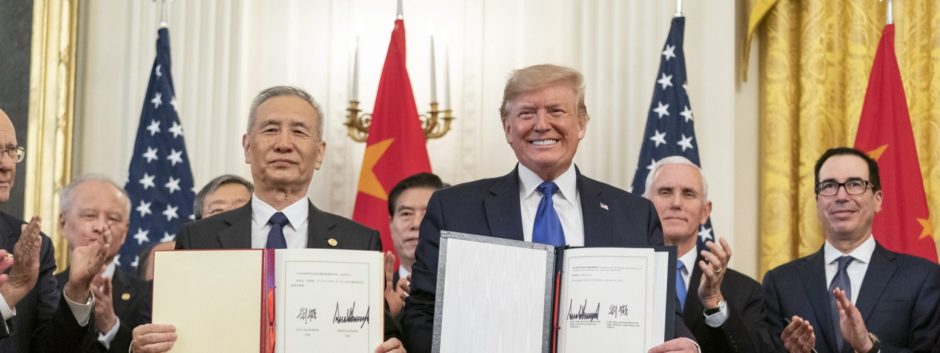
A deal by the US and China goes some way to ending the two-year trade war, with particular support in the agreement for agriculture and energy exports.
The phase one trade agreement sees US President Donald Trump “making good on his promise to fix the failed policies of the past and deliver fairer trader for the United States”, a statement from the White House said. “This agreement will help level the playing field for America’s innovators to compete and win.”
It went on to say China had agreed to “significant structural reforms” in a number of areas, although certain issues remain unresolved. In particular, concerns remain over the Chinese threat of cyber operations and subsidies. The US has agreed to reverse its definition of China as a currency manipulator. The majority of US tariffs on Chinese goods remain in place until the second phase agreement is reached.
China has agreed to increase its imports of US goods and services by at least $200 billion, with the White House statement highlighting the Asian state would buy $40-50bn of agricultural goods per year for two years. According to the US government, total agricultural exports to China in 2018 were $9.3bn.
The document setting out the new plan, specifies that China will buy at least $18.5bn more energy products in 2020, versus the 2017 baseline, with this rising to $33.9bn above the baseline in 2021. After this, values were not specified but the “trajectory” is expected to continue.
“Fifty billion dollars’ worth of energy. So that’s great for our energy people. We’re the number one in the world now; we weren’t. We’re now the number-one energy group in the world. We’re bigger than Saudi Arabia, and we’re bigger than Russia. We’re bigger than everybody,” Trump said, before going on to say he would approve new pipelines in Texas momentarily. US energy exports to China reached $8.6bn in 2017, from $2.6bn in 2016.
It is not clear that China will be able to import agriculture and energy from the US in the required volumes.
In comments on the agricultural plan, Trump appeared to acknowledge the US may struggle to reach the target. “I said, ‘No, make it $50 [billion]. What difference does it make? Make it $50 [billion].’ They say, ‘Sir, our farmers can’t produce that much.’ I said, ‘I love our farmers. Let them tell me they can’t do it.’ And I said, ‘Tell them to go out and buy a larger tractor. Buy a little more land.’ But they’ll be able to do it.”
Progress will be tracked through official Chinese and US data. The released plan did not specify which US energy exports would be prioritised, naming LNG, crude oil, refined products and coal.
Chinese President Xi Jinping did not sign the agreement, sending Chinese Vice Premier Liu He in his place. Trump said he would go to China in “not too distant future”, describing Xi as a “very, very good friend of mine”. Xi, in a message conveyed by Liu, said the deal was “good for China, for the US, and for the whole world”.
Maintaining the “healthy and steady growth of China-US relations serves the interest of both countries and requires joint efforts from both sides”, Xi continued.
The US imposed tariffs on China in 2018, with a tit-for-tat escalation seeing Beijing responding in kind. The price on China was higher, but a number of US sectors have felt the squeeze as a result of the falling out. Farmers have been hard hit, while LNG exporters have also felt the strain. China imposed tariffs on energy supplies from the US in June 2018.
There is an electoral need behind a de-escalation. While the US has provided substantial support to farmers, discontent with the issue has grown as the country heads towards presidential elections, in November of this year.
Attending the signing were a number of energy industry luminaries, including Cheniere Energy’s Jack Fusco, Continental Resources’ Harold Hamm and ConocoPhillips’ Ryan Lance.
